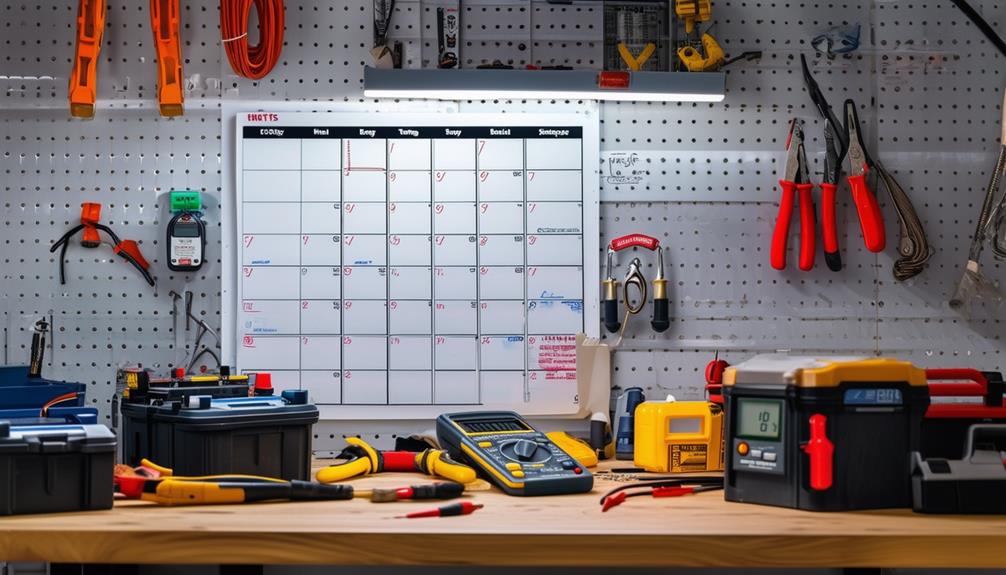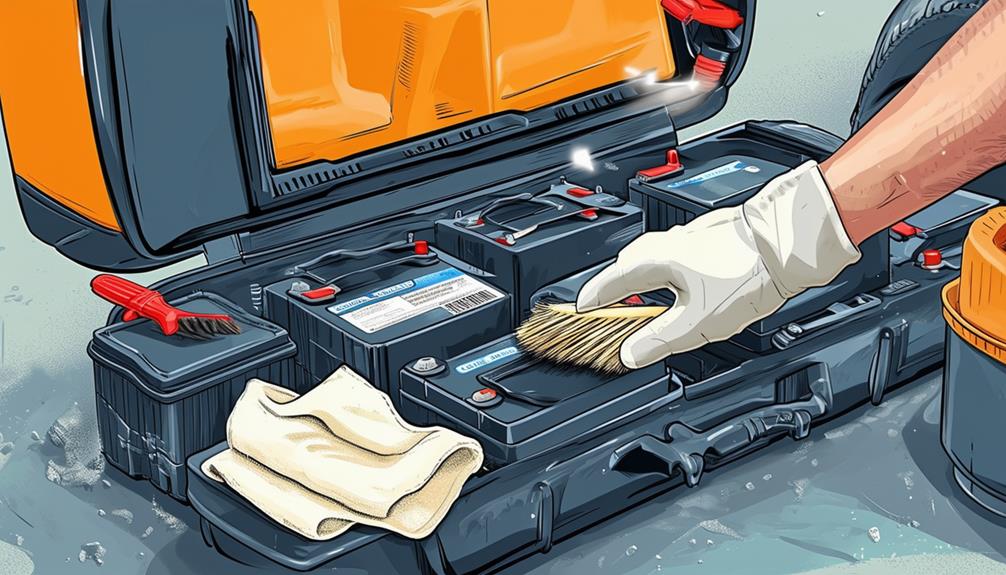Tips for Extending the Life of Your Emergency Light Batteries

To extend the lifespan of your emergency light batteries, focus on a few essential maintenance practices. Regularly cleaning the battery terminals can prevent corrosion, while using the appropriate chargers ensures optimal performance.
Monthly testing and proper charging techniques are also crucial. For example, discharging sealed lead-acid (SLA) batteries to 50% before a full recharge and periodically fully discharging nickel-cadmium (NiCad) batteries can significantly improve their longevity.
Interested in integrating these methods into your routine? Let's explore each aspect in greater detail.
Annual Testing Procedures
Conducting annual tests on emergency light batteries is crucial to ensure compliance with local fire or building codes and to verify their functionality during emergencies. For optimal results, these tests should be conducted during daylight hours and in favorable weather conditions, which provide ideal visibility and minimize associated risks.
To avoid potential power outages during an emergency, it's advisable to stagger the testing of your emergency lights over several days rather than testing them all at once.
During each test, carefully monitor the duration each emergency light remains illuminated. According to local fire codes, these lights must stay on for at least 90 minutes.
If any emergency light fails to meet the 90-minute requirement, replace its battery immediately to maintain compliance and ensure safety.
Adhering to these testing procedures not only ensures your emergency light batteries meet regulatory standards but also helps extend their lifespan by proactively identifying and addressing any issues.
Monthly Maintenance Tips
To ensure the reliability of your emergency lights, perform monthly tests by switching them to test mode and verifying that they maintain proper brightness.
After testing, switch them back to automatic mode and check the battery charge status. Replace any faulty batteries to ensure optimal performance and longevity.
Monthly Testing Procedures
Regular monthly testing of your emergency lights ensures they're ready to function when needed. To maintain the reliability of your emergency lighting system, follow these essential procedures:
Initiate the Monthly Test:
Activate test mode or press the test button on your emergency lights. This step verifies that the lights illuminate correctly and meet performance standards.
Check Brightness:
Observe the light intensity during the test. Adjust as needed to ensure optimal illumination, which also confirms the efficiency of the battery charging process.
Restore Power:
After testing, return the lights to automatic mode or reconnect the power supply. This step ensures that the batteries are charging properly and are prepared for future use.
Replace Malfunctioning Batteries:
Immediately replace any faulty batteries identified during the test. This step is crucial for maintaining the system's reliability during power outages.
Battery Inspection Routine
Incorporate battery inspections into your monthly maintenance routine to ensure your emergency lights are always ready. A regular battery examination schedule helps maintain the reliability of your emergency lighting system. Begin with a comprehensive monthly inspection of the batteries, looking for damage such as cracks or bulges, which could signal potential issues.
Check the battery terminals for corrosion or leaks, as these can impair performance. Clean any corrosion using a mixture of baking soda and water to maintain optimal connectivity. Also, verify that the batteries are holding a charge and functioning correctly by using a multimeter to measure the voltage, ensuring it aligns with the manufacturer's specifications.
If you detect any faulty or deteriorating batteries during your monthly inspection, replace them immediately. Keeping spare batteries on hand can save time and ensure your emergency lights remain operational. By integrating this battery inspection routine into your monthly maintenance, you extend the life of your emergency light batteries and maintain a dependable lighting system when you need it most.
Charge and Discharge Cycles
Regular maintenance of your batteries is essential to ensure optimal performance and reliability of your emergency lighting system. Conducting monthly charge and discharge cycles is a straightforward yet highly effective practice.
Follow these steps to keep your emergency lights in peak condition:
- Simulate a Discharge: Switch your fixtures to Test mode or disconnect the power for at least 30 seconds. This simulates an emergency and tests the battery's response.
- Check Brightness and Functionality: Ensure the emergency lights maintain proper brightness throughout the test. Dim lights may indicate a battery issue that needs attention.
- Return to Automatic Mode: After testing, switch the fixtures back to Automatic mode or restore power. This allows the battery to return to its normal charging cycle.
- Inspect for Malfunctions: Look for any signs of malfunction in the batteries. Replace any units that don't pass the test to avoid future failures.
Battery Maintenance Techniques

To keep your emergency light batteries in optimal condition, conduct monthly discharge cycles appropriate for your battery type.
Regularly clean the battery terminals to ensure a good connection and prevent corrosion.
Always use the chargers specified in your owner's manual to avoid damage and maintain battery health.
Monthly Discharge Cycles
Performing monthly discharge cycles is essential for maintaining the longevity and reliability of your emergency light batteries. Regular discharging and recharging ensure that your batteries remain in optimal condition, ready to perform when needed.
For sealed lead-acid (SLA) batteries, aim to discharge them to about 50% capacity each month. This practice helps sustain their performance and extends their lifespan.
For NiCad batteries, a full discharge and recharge cycle should be performed monthly to prevent the memory effect, which can reduce their capacity over time.
Gel-cell batteries also benefit from monthly discharge and recharge cycles, preventing premature failure. Similarly, Nickel-metal hydride batteries require this routine to maintain their long-term reliability in emergency situations.
To keep your batteries in excellent condition, follow these monthly steps:
- Discharge SLA batteries to 50% capacity - Maintains performance and longevity.
- Fully discharge and recharge NiCad batteries - Prevents memory effect and sustains capacity.
- Discharge and recharge Gel-cell batteries - Prevents premature failure.
- Discharge and recharge Nickel-metal hydride batteries - Ensures long-term reliability.
Cleaning Battery Terminals
Regularly cleaning battery terminals ensures your emergency light batteries perform optimally and last longer. To maintain peak performance, start by wiping the terminals with a dry cloth to remove dirt and debris. This simple step keeps electrical contact strong and unobstructed.
For heavily soiled terminals, use a soft brush to clean them thoroughly. This extra effort prevents buildup that can impede functionality. Clean terminals are vital for maintaining good electrical contact and preventing corrosion.
Corrosion significantly reduces battery efficiency and lifespan. Regular cleaning of the terminals is a crucial part of battery maintenance that directly contributes to maximizing their lifespan.
Proper maintenance ensures your emergency light system is always ready when needed. These simple techniques optimize both performance and longevity of your emergency light batteries.
Using Proper Chargers
Maintaining the health and performance of your emergency light batteries requires the use of a high-quality charger with an appropriate charge controller. The right charger ensures that the correct charging voltage, typically between 3.55V to 3.6V per cell, is applied. This optimizes battery performance and longevity.
To maximize the life and efficiency of your emergency light batteries, adhere to these practices:
- Avoid Overcharging: Overcharging can lead to overheating and significant wear, reducing battery lifespan. A proper charge controller prevents this by stopping the charge once the battery reaches full capacity.
- Prevent Undercharging: Undercharging can also impair battery health. Ensure your charger maintains a consistent voltage to keep the battery in optimal condition.
- Regular Charging: Frequent charging is essential. Make it a habit to charge your batteries regularly to maintain their capacity and functionality over time.
- Avoid Deep Discharge: Discharging below 30% can significantly shorten battery lifespan. Keeping your batteries within a safe charge range extends their life.
Caring for SLA Batteries
Proper care for SLA batteries ensures their longevity and reliability in emergency lighting systems. To maintain peak performance, discharge your SLA batteries to 50% capacity and then fully recharge them monthly. This routine, combined with monthly testing, sustains battery health and prevents failures during actual emergencies.
Turn on the emergency lights for at least 90 minutes each month to verify the batteries can handle the required load. Regular maintenance is crucial for the longevity and reliability of SLA batteries. Always use appropriate charging techniques to avoid overcharging or undercharging, which can lead to premature battery failure.
It's also important to turn off the lights before the batteries are fully discharged during normal operations to prevent damage. With proper maintenance, SLA batteries can last between 10 to 15 years. Monthly testing and proper charging routines are essential to achieving this lifespan.
Handling NiCad Batteries

To prevent the memory effect and maintain full capacity, fully discharge and recharge your NiCad batteries monthly. This simple yet vital step helps ensure your batteries remain in top shape and perform optimally when you need them. NiCad batteries typically last 5 to 10 years, but proper care can significantly extend their lifespan.
Follow a regular maintenance schedule to keep your NiCad batteries fully charged and operational. During monthly testing, make sure to fully discharge the batteries until the light goes out. This practice helps in preventing the memory effect, which can significantly reduce battery capacity if not managed properly.
Handle your NiCad batteries carefully to prevent damage and ensure they last.
Here are four crucial tips for maintaining NiCad batteries:
- Fully Discharge Monthly: This prevents the memory effect.
- Handle with Care: Physical damage can shorten battery lifespan.
- Regular Testing: Perform monthly testing to maintain peak performance.
- Consistent Maintenance: Stick to a regular maintenance schedule to keep them operating at full capacity.
Charging Best Practices
Maintaining and charging your NiCad batteries correctly is crucial for their longevity and performance. To start, use a high-quality charger equipped with the proper charge controller to ensure optimal battery health. Apply a charging voltage of 3.55V to 3.6V per cell to prevent damage and extend the battery's life.
Regular charging is essential to preserve battery capacity. Avoid overcharging or undercharging, as both can degrade performance. Charge your batteries every three months to prevent self-discharge and keep them in top condition. Additionally, avoid discharging your batteries below 30% charge to prolong their lifespan and maintain efficiency.
Here's a quick reference table for charging best practices:
| Best Practice | Description | Benefit |
|---|---|---|
| High-quality charger | Maintains optimal battery health | Prolongs lifespan |
| Correct charge controller | Manages charging cycles | Prevents damage |
| Appropriate charging voltage | 3.55V - 3.6V per cell | Ensures efficient charging |
| Regular charging | Charge every three months | Maintains performance |
| Avoid deep discharging | Keep above 30% charge level | Extends battery life |
Conclusion
To extend the lifespan of your emergency light batteries, follow these essential tips. Regular testing, monthly maintenance, and proper battery care are crucial.
For SLA batteries, discharge them to 50% monthly. NiCad batteries should be fully discharged and recharged to prevent the memory effect.
Use the recommended chargers and techniques to ensure your emergency lights are always operational. By adhering to these practices, you'll significantly optimize your batteries' lifespan.




